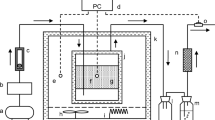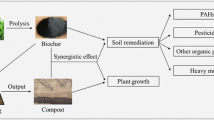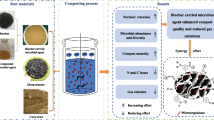Abstract
Different strategies have been tested to reduce nitrogen losses and gaseous ammonia emissions during composting. Among them, the supplementation of the composting mixture with biochar has shown good results and has attracted increasing attention from researchers over more than a decade. In order to capitalise on the numerous existing results, the relevant data from the literature were subjected to descriptive statistics and to a Pearson parametric correlation analysis. The statistical treatment of the literature data confirms that biochar reduces nitrogen losses, ammonia and nitrous oxide emissions during composting with highly variable performance (respectively reduction of 26.2% ± 16.7%; 46% ± 26.4%; 46.1% ± 31.1%). Statistically significant correlations were identified between N losses and biochar properties. However, the PCA results show that only 44.75% of the variability in the N loss reduction dataset and 57.8% of the ammonia emission reduction dataset were explained by the main variables available in the literature. This suggests that much of the variability in biochar performance remains unexplained. The large number of variables involved in the process and the lack of fine characterisation of biochar in most studies explain the remaining difficulty in fully understanding the complex action of biochar in composting and opens up prospects for further research.
Graphical Abstract









Similar content being viewed by others
Data Availability
The datasets generated and analysed during the current study are available as an excel file (Supplementary Information - datasets_02_08_22.xlsx) submitted as supplementary information.
References
Salemdeeb, R., zu Ermgassen, E.K.H.J., Kim, M.H., Balmford, A., Al-Tabbaa, A.: Environmental and health impacts of using food waste as animal feed: a comparative analysis of food waste management options. J. Clean. Prod. 140, 871–880 (2017). https://doi.org/10.1016/j.jclepro.2016.05.049
Leip, A., Billen, G., Garnier, J., Grizzetti, B., Lassaletta, L., Reis, S., Simpson, D., Sutton, M.A., De Vries, W., Weiss, F., Westhoek, H.: Impacts of european livestock production: nitrogen, sulphur, phosphorus and greenhouse gas emissions, land-use, water eutrophication and biodiversity. Environ. Res. Lett. (2015). https://doi.org/10.1088/1748-9326/10/11/115004
Vallero, D.A.: Air pollution biogeochemistry. In: Vallero, D.A. (ed.) Air Pollution Calculations, pp. 175–206. Elsevier, Amsterdam (2019)
Beck-Friis, B., Smårs, S., Jönsson, H., Kirchmann, H.: Gaseous emissions of carbon dioxide, ammonia and nitrous oxide from organic household waste in a compost reactor under different temperature regimes. J. Agric. Eng. Res. 78, 423–430 (2001). https://doi.org/10.1006/jaer.2000.0662
Cáceres, R., Malińska, K., Marfà, O.: Nitrification within composting: a review. Waste Manag. 72, 119–137 (2018). https://doi.org/10.1016/j.wasman.2017.10.049
Dabert, P., Pourcher, A.-M.: Aspects biochimiques et microbiologiques du compostage. In: De Guardia A. (eds.). Compostage et Composts: Avancées Scientifiques et Techniques, pp. 7–39. Lavoisier Tec & Doc, (2018)
Mohammed-Nour, A., Al-Sewailem, M., El-Naggar, A.H.: The influence of alkalization and temperature on ammonia recovery from cow manure and the chemical properties of the effluents. Sustainability (2019). https://doi.org/10.3390/su11082441
Sánchez-Monedero, M.A., Roig, A., Paredes, C., Bernal, M.P.: Nitrogen transformation during organic waste composting by the rutgers system and its effects on pH, EC and maturity of the composting mixtures. Bioresour. Technol. 78, 301–308 (2001). https://doi.org/10.1016/S0960-8524(01)00031-1
Vandecasteele, B., Willekens, K., Steel, H., D’Hose, T., Van Waes, C., Bert, W.: Feedstock mixture composition as key factor for C/P ratio and phosphorus availability in composts: role of biodegradation potential, biochar amendment and calcium content. Waste Biomass Valoriz. 8, 2553–2567 (2017). https://doi.org/10.1007/s12649-016-9762-3
Tomczyk, A., Sokołowska, Z., Boguta, P.: Biochar physicochemical properties: pyrolysis temperature and feedstock kind effects. Rev. Environ. Sci. Biotechnol. 19, 191–215 (2020). https://doi.org/10.1007/s11157-020-09523-3
Kim, K.H., Kim, J.Y., Cho, T.S., Choi, J.W.: Influence of pyrolysis temperature on physicochemical properties of biochar obtained from the fast pyrolysis of pitch pine (Pinus rigida). Bioresour. Technol. 118, 158–162 (2012). https://doi.org/10.1016/j.biortech.2012.04.094
Manyà, J.J.: Pyrolysis for biochar purposes: a review to establish current knowledge gaps and research needs. Environ. Sci. Technol. 46, 7939–7954 (2012). https://doi.org/10.1021/es301029g
Atkinson, C.J., Fitzgerald, J.D., Hipps, N.A.: Potential mechanisms for achieving agricultural benefits from biochar application to temperate soils: A review. Plant Soil 337, 1–18 (2010). https://doi.org/10.1007/s11104-010-0464-5
Sohi, S.P., Krull, E., Lopez-Capel, E., Bol, R.: A review of biochar and its use and function in soil. Adv. Agron. 105, 47–82 (2010). https://doi.org/10.1016/S0065-2113(10)05002-9
Sanchez-Monedero, M.A., Cayuela, M.L., Roig, A., Jindo, K., Mondini, C., Bolan, N.: Role of biochar as an additive in organic waste composting. Bioresour. Technol. 247, 1155–1164 (2018). https://doi.org/10.1016/j.biortech.2017.09.193
Prost, K., Borchard, N., Siemens, J., Kautz, T., Séquaris, J.-M., Möller, A., Amelung, W.: Biochar affected by composting with farmyard manure. J. Environ. Qual. 42, 164–172 (2013). https://doi.org/10.2134/jeq2012.0064
Kammann, C.I., Schmidt, H.P., Messerschmidt, N., Linsel, S., Steffens, D., Müller, C., Koyro, H.W., Conte, P., Stephen, J.: Plant growth improvement mediated by nitrate capture in co-composted biochar. Sci. Rep. 5, 1–13 (2015). https://doi.org/10.1038/srep11080
Hagemann, N., Kammann, C.I., Schmidt, H.P., Kappler, A., Behrens, S.: Nitrate capture and slow release in biochar amended compost and soil. PLoS One 12, 1–16 (2017). https://doi.org/10.1371/journal.pone.0171214
Zhang, F., Wei, Z., Wang, J.J.: Integrated application effects of biochar and plant residue on ammonia loss, heavy metal immobilization, and estrogen dissipation during the composting of poultry manure. Waste Manag. 131, 117–125 (2021). https://doi.org/10.1016/j.wasman.2021.05.037
Puth, M.T., Neuhäuser, M., Ruxton, G.D.: Effective use of Pearson’s product-moment correlation coefficient. Anim. Behav. 93, 183–189 (2014). https://doi.org/10.1016/j.anbehav.2014.05.003
Hestrin, R., Enders, A., Lehmann, J.: Ammonia volatilization from composting with oxidized biochar. J. Environ. Qual. 49, 1690–1702 (2020). https://doi.org/10.1002/jeq2.20154
Lehmann, J., Joseph, S.: Biochar for Environmental Management: Science, Technology and Implementation, 2nd edn. Taylor and Francis, New York (2015)
Suliman, W., Harsh, J.B., Abu-Lail, N.I., Fortuna, A.M., Dallmeyer, I., Garcia-Perez, M.: Influence of feedstock source and pyrolysis temperature on biochar bulk and surface properties. Biomass Bioenergy 84, 37–48 (2016). https://doi.org/10.1016/j.biombioe.2015.11.010
Novak, J.M., Johnson, M.G.: Elemental and spectroscopic characterization of low-temperature (350 °C) lignocellulosic- and manure-based designer biochars and their use as soil amendments. Elsevier, Amsterdam (2019)
Chen, W., Liao, X., Wu, Y., Liang, J.B., Mi, J., Huang, J., Zhang, H., Wu, Y., Qiao, Z., Li, X., Wang, Y.: Effects of different types of biochar on methane and ammonia mitigation during layer manure composting. Waste Manag. 61, 506–515 (2017). https://doi.org/10.1016/j.wasman.2017.01.014
Agyarko-Mintah, E., Cowie, A., Van Zwieten, L., Singh, B.P., Smillie, R., Harden, S., Fornasier, F.: Biochar lowers ammonia emission and improves nitrogen retention in poultry litter composting. Waste Manag. 61, 129–137 (2017). https://doi.org/10.1016/j.wasman.2016.12.009
Shaaban, A., Se, S.M., Dimin, M.F., Juoi, J.M., Husin, M., Mitan, M.H.: Influence of heating temperature and holding time on biochars derived from rubber wood sawdust via slow pyrolysis. J. Anal. Appl. Pyrolysis 107, 31–39 (2014). https://doi.org/10.1016/j.jaap.2014.01.021
Tag, A.T., Duman, G., Ucar, S., Yanik, J.: Effects of feedstock type and pyrolysis temperature on potential applications of biochar. J. Anal. Appl. Pyrolysis 120, 200–206 (2016). https://doi.org/10.1016/j.jaap.2016.05.006
Claoston, N., Samsuri, A.W., Ahmad Husni, M.H., Mohd Amran, M.S.: Effects of pyrolysis temperature on the physicochemical properties of empty fruit bunch and rice husk biochars. Waste Manag. Res. 32, 331–339 (2014). https://doi.org/10.1177/0734242X14525822
Janczak, D., Malińska, K., Czekała, W., Cáceres, R., Lewicki, A., Dach, J.: Biochar to reduce ammonia emissions in gaseous and liquid phase during composting of poultry manure with wheat straw. Waste Manag. 66, 36–45 (2017). https://doi.org/10.1016/j.wasman.2017.04.033
López-Cano, I., Roig, A., Cayuela, M.L., Alburquerque, J.A., Sánchez-Monedero, M.A.: Biochar improves N cycling during composting of olive mill wastes and sheep manure. Waste Manag. 49, 553–559 (2016). https://doi.org/10.1016/j.wasman.2015.12.031
Abrishamkesh, S., Gorji, M., Asadi, H., Bagheri-Marandi, G.H., Pourbabaee, A.A.: Effects of rice husk biochar application on the propertiesof alkaline soil and lentil growth. Plant Soil Environ. 62, 475–482 (2015). https://doi.org/10.17221/117/2015-PSE
Zhang, J., Liu, J., Liu, R.: Effects of pyrolysis temperature and heating time on biochar obtained from the pyrolysis of straw and lignosulfonate. Bioresour. Technol. 176, 288–291 (2015). https://doi.org/10.1016/j.biortech.2014.11.011
Lange, S.F., Allaire, S.E., Charles, A., Auclair, I.K., Bajzak, C.E.: Physicochemical properties of 43 biochars. CRMR-2018-SA-2-EN. Centre de Recherche sur les Matériaux Renouvelables, Université Laval and GECA Environnement, Quebec Qc. Canada, 60 p. (2018). https://www.researchgate.net/profile/Suzanne-Allaire/publication/323366209_Physicochemical_Properties_of_43_Biochars_A_Co-Production_of_Universite_Laval_and_GECA_Environnement_Production_Team/links/5a903a4945851535bcd5811d/Physicochemical-Properties-of-43-Biochars-A-Co-Production-of-Universite-Laval-and-GECA-Environnement-Production-Team.pdf Accessed July 2022
Pardo, G., Moral, R., Aguilera, E., del Prado, A.: Gaseous emissions from management of solid waste: a systematic review. Glob. Change Biol. 21, 1313–1327 (2015). https://doi.org/10.1111/gcb.12806
Chowdhury, M.A., de Neergaard, A., Jensen, L.S.: Composting of solids separated from anaerobically digested animal manure: effect of different bulking agents and mixing ratios on emissions of greenhouse gases and ammonia. Biosyst. Eng. 124, 63–77 (2014). https://doi.org/10.1016/j.biosystemseng.2014.06.003
Kim, Y., Kim, T.H., Ergün, T.: The instability of the Pearson correlation coefficient in the presence of coincidental outliers. Financ. Res. Lett. 13, 243–257 (2015). https://doi.org/10.1016/j.frl.2014.12.005
Zhang, M., Song, G., Gelardi, D.L., Huang, L., Khan, E., Mašek, O., Parikh, S.J., Ok, Y.S.: Evaluating biochar and its modifications for the removal of ammonium, nitrate, and phosphate in water. Water Res. (2020). https://doi.org/10.1016/j.watres.2020.116303
Joseph, S., Kammann, C.I., Shepherd, J.G., Conte, P., Schmidt, H.P., Hagemann, N., Rich, A.M., Marjo, C.E., Allen, J., Munroe, P., Mitchell, D.R.G., Donne, S., Spokas, K., Graber, E.R.: Microstructural and associated chemical changes during the composting of a high temperature biochar: mechanisms for nitrate, phosphate and other nutrient retention and release. Sci. Total Environ. 618, 1210–1223 (2018). https://doi.org/10.1016/j.scitotenv.2017.09.200
Archanjo, B.S., Mendoza, M.E., Albu, M., Mitchell, D.R.G., Hagemann, N., Mayrhofer, C., Mai, T.L.A., Weng, Z., Kappler, A., Behrens, S., Munroe, P., Achete, C.A., Donne, S., Araujo, J.R., van Zwieten, L., Horvat, J., Enders, A., Joseph, S.: Nanoscale analyses of the surface structure and composition of biochars extracted from field trials or after co-composting using advanced analytical electron microscopy. Geoderma 294, 70–79 (2017). https://doi.org/10.1016/j.geoderma.2017.01.037
Sun, D., Lan, Y., Xu, E.G., Meng, J., Chen, W.: Biochar as a novel niche for culturing microbial communities in composting. Waste Manag. 54, 93–100 (2016). https://doi.org/10.1016/j.wasman.2016.05.004
Quin, P., Joseph, S., Husson, O., Donne, S., Mitchell, D., Munroe, P., Phelan, D., Cowie, A., Van Zwieten, L.: Lowering N2O emissions from soils using eucalypt biochar: the importance of redox reactions. Sci. Rep. 5, 1–14 (2015). https://doi.org/10.1038/srep16773
Zeng, G., Zhang, J., Chen, Y., Yu, Z., Yu, M., Li, H., Liu, Z., Chen, M., Lu, L., Hu, C.: Relative contributions of archaea and bacteria to microbial ammonia oxidation differ under different conditions during agricultural waste composting. Bioresour. Technol. 102, 9026–9032 (2011). https://doi.org/10.1016/j.biortech.2011.07.076
Guo, H., Gu, J., Wang, X., Yu, J., Nasir, M., Zhang, K., Sun, W.: Microbial driven reduction of N2O and NH3 emissions during composting: effects of bamboo charcoal and bamboo vinegar. J. Hazard. Mater. 390, 121292 (2020). https://doi.org/10.1016/j.jhazmat.2019.121292
Yang, Y., Kumar Awasthi, M., Wu, L., Yan, Y., Lv, J.: Microbial driving mechanism of biochar and bean dregs on NH3 and N2O emissions during composting. Bioresour. Technol. 315, 123829 (2020). https://doi.org/10.1016/j.biortech.2020.123829
Wang, C., Lu, H., Dong, D., Deng, H., Strong, P.J., Wang, H., Wu, W.: Insight into the effects of biochar on manure composting: evidence supporting the relationship between N2O emission and denitrifying community. Environ. Sci. Technol. 47, 7341–7349 (2013). https://doi.org/10.1021/es305293h
Li, S., Song, L., Jin, Y., Liu, S., Shen, Q., Zou, J.: Linking N2O emission from biochar–amended composting process to the abundance of denitrify (nirK and nosZ) bacteria community. AMB Express (2016). https://doi.org/10.1186/s13568-016-0208-x
Shan, G., Li, W., Liu, J., Zhu, L., Hu, X., Yang, W., Tan, W., Xi, B.: Nitrogen loss, nitrogen functional genes, and humification as affected by hydrochar addition during chicken manure composting. Bioresour. Technol. 369, 128512 (2023). https://doi.org/10.1016/j.biortech.2022.128512
Deng, L., Liu, W., Chang, N., Sun, L., Zhang, J., Bello, A., Uzoamaka Egbeagu, U., Shi, S., Sun, Y., Xu, X.: Disentangling the coupling relationships between functional denitrifiers and nitrogen transformation during cattle-manure and biochar composting: a novel perspective. Bioresour. Technol. 367, 128235 (2023). https://doi.org/10.1016/j.biortech.2022.128235
Schmidt, H.P., Kammann, C., Hagemann, N., Leifeld, J., Bucheli, T.D., Sánchez Monedero, M.A., Cayuela, M.L.: Biochar in agriculture–a systematic review of 26 global meta-analyses. GCB Bioenergy 13, 1708–1730 (2021). https://doi.org/10.1111/gcbb.12889
Funding
This research received a funding from the Regional Council of Bretagne, France.
Author information
Authors and Affiliations
Contributions
All authors contributed to the study conception and design. Material preparation, data collection and analysis were performed by MVFS and AT. The first draft of the manuscript was written by MVFS and all authors commented on previous versions of the manuscript. All authors worked out, read and approved the final manuscript. Moreover, thanks are due to PD who accepted to read and proof the last version of the manuscript.
Corresponding author
Ethics declarations
Competing interest
The authors have no relevant financial or non-financial interests to disclose.
Additional information
Publisher’s Note
Springer Nature remains neutral with regard to jurisdictional claims in published maps and institutional affiliations.
Supplementary Information
Below is the link to the electronic supplementary material.
Rights and permissions
Springer Nature or its licensor (e.g. a society or other partner) holds exclusive rights to this article under a publishing agreement with the author(s) or other rightsholder(s); author self-archiving of the accepted manuscript version of this article is solely governed by the terms of such publishing agreement and applicable law.
About this article
Cite this article
Vieira Firmino, M., Trémier, A. Nitrogen Losses Mitigation by Supplementing Composting Mixture with Biochar: Research of the Ruling Parameters. Waste Biomass Valor 15, 959–971 (2024). https://doi.org/10.1007/s12649-023-02204-6
Received:
Accepted:
Published:
Issue Date:
DOI: https://doi.org/10.1007/s12649-023-02204-6




